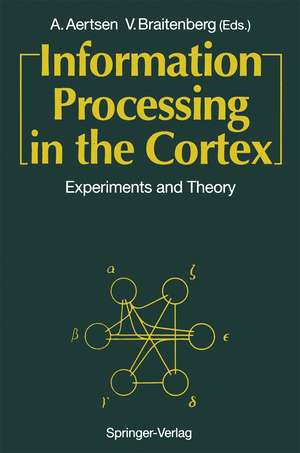Information Processing in the Cortex: Experiments and Theory
Editat de Ad Aertsen, Valentino Braitenbergen Limba Engleză Paperback – 19 apr 2012
Preț: 649.87 lei
Preț vechi: 764.55 lei
-15% Nou
Puncte Express: 975
Preț estimativ în valută:
124.36€ • 132.98$ • 103.68£
124.36€ • 132.98$ • 103.68£
Carte tipărită la comandă
Livrare economică 17 aprilie-01 mai
Preluare comenzi: 021 569.72.76
Specificații
ISBN-13: 9783642499692
ISBN-10: 3642499694
Pagini: 492
Ilustrații: XII, 477 p.
Dimensiuni: 155 x 235 x 26 mm
Greutate: 0.68 kg
Ediția:Softcover reprint of the original 1st ed. 1992
Editura: Springer Berlin, Heidelberg
Colecția Springer
Locul publicării:Berlin, Heidelberg, Germany
ISBN-10: 3642499694
Pagini: 492
Ilustrații: XII, 477 p.
Dimensiuni: 155 x 235 x 26 mm
Greutate: 0.68 kg
Ediția:Softcover reprint of the original 1st ed. 1992
Editura: Springer Berlin, Heidelberg
Colecția Springer
Locul publicării:Berlin, Heidelberg, Germany
Public țintă
ResearchCuprins
One Anatomical Connectivity.- Randomness and Constraints in the Cortical Neuropil.- An Example for Specific Connections in the Visual Cortex.- A Probabilistic Approach to the Analysis of Propagation Delays in Large Cortical Axonal Trees.- Two Cortical Activity at Different Levels of Resolution in Space and Time.- The Biological Role of Neocortex.- Coding and Computation in the Cortex: Single-Neuron Activity and Cooperative Phenomena.- Novel Strategies to Unravel Mechanisms of Cortical Function: From Macro- to Micro-Electrophysiological Recordings.- Neuronal Population Coding and the Elephant.- Is Spike Frequency the Critical Factor in Recognising the Visual Stimulus?.- Independence.- Single Cells versus Neuronal Assemblies.- Neurons as Computational Elements.- Some Quantitative Remarks about the Retina, the Primary Visual Cortex, and Visual Perception in Humans.- Cells in the Visual Cortex are not just Local Receptive-Field Filters.- Dynamics of Activity in Biology-Oriented Neural Network Models: Stability at Low Firing Rates.- A Theoretical Approach to the Late Components of the Event-Related Brain Potential.- Cortical Information Processing as Viewed from the Mass-Action Domain of Evoked Potentials.- Current Source Density Analysis of Spatio-Temporal Fluorescence Maps in Organotypical Slice Cultures.- The Contribution of the Striatum to Cortical Function.- Reconstruction and Characterisation of Neuronal Dynamics: How Attractive is Chaos?.- Three Visual Cortex.- Horizontal Intracortical Contributions to Functional Specificity in Cat Visual Cortex.- Excitatory, Inhibitory and Neuromodulatory Influences in Central Visual Function.- Microcircuitry of Cat Visual Cortex.- Principles of Global Visual Processing of Local Features can be Investigated with Parallel Single-Cell-and Group-Recordings from the Visual Cortex.- Imaging the Functional Architecture of Cat Area 18 in vivo.- Blobs or Slabs—is that the Question?.- How Ideas Survive Evidence to the Contrary: A Comment on Data Display and Modelling.- Cortical Maps.- Four Outlook.- Views of a Theoretical Physicist.- Manifesto of Brain Science.












